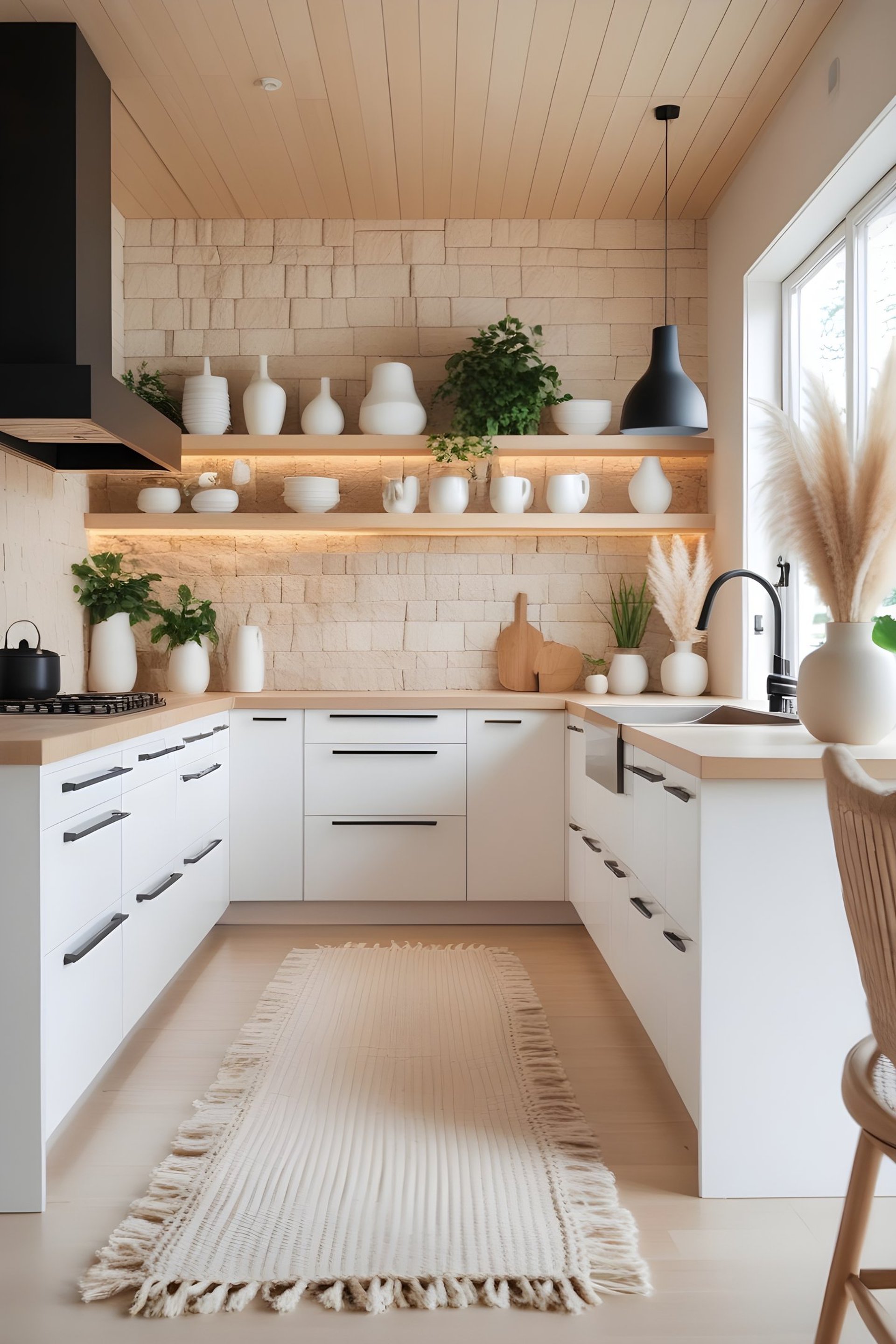
The Art of the Wabi-Sabi Scandi Kitchen: Simplicity, Soul, and Everyday Beauty
Create a calm, soulful kitchen with the Wabi-Sabi Scandi style—where natural beauty, simplicity, and quiet elegance meet.
KITCHEN INSPIRATION
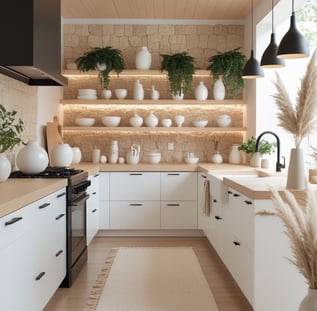

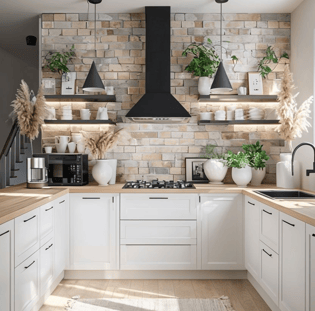

In an age of visual overload and disposable trends, many of us crave stillness—a space that feels grounded, honest, and deeply nourishing. Enter the Wabi-Sabi Scandi Kitchen: a quietly elegant fusion of Japanese wabi-sabi and Nordic minimalism that redefines how we relate to our homes and ourselves.
But how do you actually achieve this aesthetic? What makes a kitchen feel calm, soulful, and uncontrived? Let’s go deep into what this style is, where it comes from, why it resonates—and how to thoughtfully bring it into your kitchen.
What Is a Wabi-Sabi Scandi Kitchen?
This hybrid style marries two design philosophies that may seem geographically distant, but spiritually aligned:
Wabi-Sabi (Japan)
Wabi-sabi is a Japanese aesthetic rooted in Zen Buddhism. It embraces imperfection, impermanence, and the natural beauty of things that are weathered, aged, or handmade. Think: a hand-thrown ceramic mug, the patina of aged wood, or an uneven linen curtain that moves softly with the breeze. It’s not about rustic chic—it’s about humility, authenticity, and being present.
Scandinavian Design (Nordics)
Scandi design values function, simplicity, and a bright, uncluttered space. Born from the long, dark Nordic winters, it emphasizes light, natural materials, and a connection to nature. Clean lines, pale woods, cozy textures, and a muted palette define the look. It’s about making everyday living beautiful and sustainable.
Put them together, and you get a kitchen that feels alive, quietly elegant, and full of soul—where functionality meets poetry.
The Common Challenges—and How to Overcome Them
Creating a Wabi-Sabi Scandi kitchen isn’t just about mood boards and color palettes. There are real, practical challenges that can prevent your kitchen from reaching this tranquil, grounded look. Here’s what often gets in the way—and what to do about it.
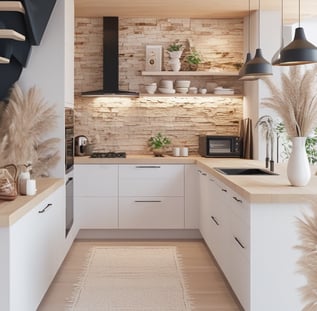

How to Build a Wabi-Sabi Scandi Kitchen, Step-by-Step
Creating a kitchen that’s both beautifully minimalist and soulfully imperfect doesn’t have to be overwhelming. The key is intention—choosing elements that feel natural, functional, and calming. Here’s your step-by-step roadmap to designing a Wabi-Sabi Scandi kitchen that nurtures both your space and your spirit.
1. Start with a Neutral, Earthy Base
The foundation of this look is a warm, organic color palette. Steer clear of stark, clinical whites—instead, opt for hues that feel soft, chalky, and grounded.
Try:
Walls: Limewash, clay-based paint, or matte off-whites that absorb light gently
Cabinetry: Muted shades like mushroom, sage, smoky grey, or dusty blue
Flooring: Pale timber, lightly weathered oak, or even soft-toned polished concrete for a natural, lived-in look
These earthy tones set a serene backdrop and allow the textures and imperfections in your materials to shine.
2. Bring in Soulful Imperfection
Wabi-sabi celebrates character and the beauty of age. Let your kitchen tell a story through materials that show life and use.
Incorporate:
Reclaimed wood shelves or countertops with natural wear
Hand-thrown ceramics—no two pieces are exactly alike
Crackled glaze pottery and uneven-edged plates for tactile charm
Linen textiles—wrinkled, soft, and beautifully imperfect
Every item should feel honest and human—nothing over-polished, nothing fake.
3. Choose Quality over Quantity
Scandinavian philosophy favors function and longevity over excess. Instead of filling cupboards with matching sets, curate your essentials.
Invest in fewer, meaningful items:
A cast iron skillet that gets better with time
A wooden spoon darkened by years of cooking
A mortar and pestle that lives on your counter as both a tool and decor
Think of your tools as heirlooms in the making. Let use add to their beauty.
4. Create a Ritual Corner
Transform your kitchen into more than a work zone. Dedicate a small area to daily rituals—a place to pause and connect.
Set the mood with:
A teapot and cup for slow morning
A tiny incense holder or beeswax candle for grounding
A small vase with herbs or a seasonal bloom
Keep it clutter-free and intentional. This corner becomes your reminder to breathe and be present—even during busy days.
5. Use Nature as Decor
Rather than store-bought decor, let nature do the work. It brings in life, movement, and seasonal shifts—all central to the wabi-sabi ethos.
Ideas to try:
Keep a bundle of fresh herbs in a jar on the counter
Display foraged branches, wildflowers, or seed pods in rustic vases
Use woven baskets for fruit, garlic, or kitchen cloths
Let the outside in—open windows when you can, and allow natural sounds and breezes to become part of the space
This connection to the natural world adds depth and grounding to your kitchen environment.
Bonus Tip: Let It Evolve
A Wabi-Sabi Scandi kitchen isn’t meant to look showroom-ready. It’s meant to evolve with you. Add layers slowly, let imperfections emerge, and allow the space to shift with the seasons and your routines.
This is a kitchen designed for living—not just for looking at.
A Brief History of Wabi-Sabi & Scandi Style
Wabi-Sabi Origins
Rooted in 15th-century Japan, wabi-sabi developed from Zen tea ceremonies where rustic, imperfect bowls and sparse rooms encouraged mindfulness. It was a rebellion against showy wealth—a celebration of transience and natural simplicity.
Scandinavian Design Roots
Post-WWII, the Scandinavian movement emerged as a response to industrial excess. Designers like Alvar Aalto and Arne Jacobsen pioneered affordable, functional beauty—creating spaces that emphasized coziness (hygge), utility, and harmony with nature.
Despite oceans between them, both philosophies share key values:
🌀 Simplicity
🌿 Connection to nature
🪵 Respect for craftsmanship
⏳ Timelessness over trendiness
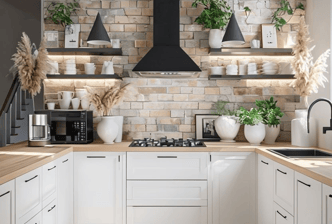

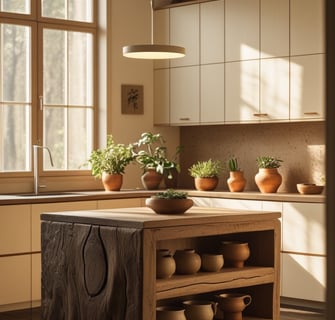

1. Clutter & Consumerism
The Problem: Most kitchens are overloaded with stuff—gadgets, mugs, duplicate utensils, and that drawer full of “maybe someday” tools.
The Fix:
Ruthlessly edit. Keep only what you use daily or weekly.
Use the one-in-one-out rule going forward.
Store what you don’t use out of sight. Open shelving? Display only beautiful or meaningful items.
Wabi-sabi mindset tip: Cherish fewer, better things.
2. Too New, Too Shiny
The Problem: Mass-market kitchens can look sterile—high gloss cabinets, pristine countertops, cold finishes.
The Fix:
Incorporate natural materials: wood, linen, stone, clay.
Mix in vintage or imperfect items: a weathered chopping board, hand-glazed tiles, or a reused butcher’s block.
Use matte finishes where possible—avoid high gloss unless it’s softened by other textures.
Scandi design tip: Create warmth with layered texture, not busy color.
3. Poor Lighting
The Problem: Fluorescent ceiling lights or harsh LEDs kill the softness of this aesthetic.
The Fix:
Use layered lighting: ambient, task, and accent.
Add soft pendant lighting over prep areas or dining nooks.
Choose warm white bulbs (2700K–3000K) to mimic natural daylight.
Maximize natural light: sheer linen curtains, reflective surfaces, pale walls.
Scandi must: Light is everything—make the most of it.
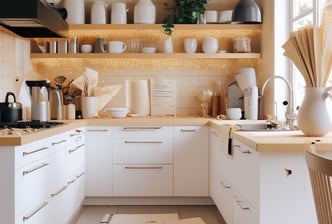

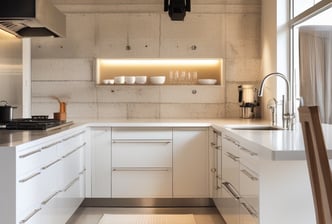

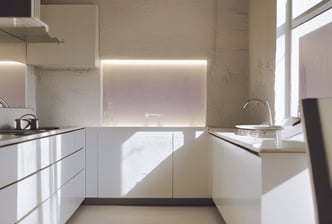

Final Thought: Why This Style Matters
A Wabi-Sabi Scandi kitchen isn’t just a look—it’s a shift in how we live.
It invites us to slow down, to appreciate what we already have, and to reconnect with daily rituals. It’s not about perfection—it’s about presence. A quiet rebellion against chaos, and a return to soulfulness.
If your kitchen feels noisy, cluttered, or soulless—this style offers a way home. Not just for your design—but for your daily life.
Inspiration Resources
Books:
“Wabi-Sabi Welcome” by Julie Pointer Adams
“The Kinfolk Home” by Nathan Williams
“The Scandinavian Home” by Niki Brantmark
Instagram accounts:
@eyeswoon
@apieceofchic
@shira_gill
@oakandink
Documentary: Minimalism: A Documentary About the Important Things (Netflix)
